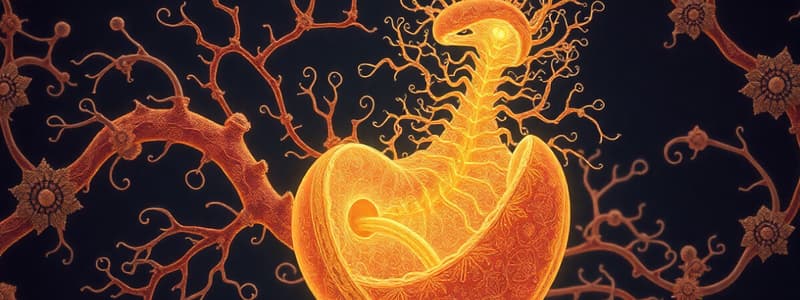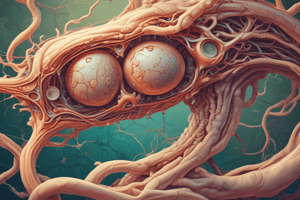Podcast
Questions and Answers
What is formed as a result of the folding of the neural plate?
What is formed as a result of the folding of the neural plate?
- Limb Buds
- Neural Tube (correct)
- Somites
- Pharyngeal Arches
What key structures develop from somites?
What key structures develop from somites?
- Vertebrae and Ribs (correct)
- Limb Muscles Only
- Digestive Organs
- Eyes and Ears
Which of the following conditions is associated with problems in neural tube formation?
Which of the following conditions is associated with problems in neural tube formation?
- Holoprosencephaly
- Cleft Palate
- Anencephaly (correct)
- Hirschsprung Disease
What developmental potential do limb buds have?
What developmental potential do limb buds have?
Which part of the neural tube undergoes cranial closure first?
Which part of the neural tube undergoes cranial closure first?
What type of cells are formed from the folds of the neural tube?
What type of cells are formed from the folds of the neural tube?
How many somites typically form during Week 4 of development?
How many somites typically form during Week 4 of development?
Which embryonic structure primarily determines the segmented body plan of the embryo?
Which embryonic structure primarily determines the segmented body plan of the embryo?
What structures are primarily formed from the sclerotome component of the somite?
What structures are primarily formed from the sclerotome component of the somite?
During week 4 of development, which significant event occurs related to the primitive heart tube?
During week 4 of development, which significant event occurs related to the primitive heart tube?
What are the derivatives of the first pharyngeal arch?
What are the derivatives of the first pharyngeal arch?
Which cranial nerve supplies the muscles formed from the second pharyngeal arch?
Which cranial nerve supplies the muscles formed from the second pharyngeal arch?
What early development marks the initial formation of limb structures in week 4?
What early development marks the initial formation of limb structures in week 4?
What is a primary function of the circulation initiated by the beating heart in week 4?
What is a primary function of the circulation initiated by the beating heart in week 4?
Which of the following structures does NOT develop from the pharyngeal arches?
Which of the following structures does NOT develop from the pharyngeal arches?
Which muscle groups are primarily developed from the myotome component of the somite?
Which muscle groups are primarily developed from the myotome component of the somite?
Flashcards
Neural Tube Formation
Neural Tube Formation
The process of converting the neural plate, a flat sheet of ectoderm, into a hollow tube that will eventually become the brain and spinal cord.
Neural Tube Closure
Neural Tube Closure
The cranial end of the neural tube closes first, followed by the caudal end. This closure process is essential for the proper formation of the brain and spinal cord.
Neural Crest Cells
Neural Crest Cells
Cells that emerge from the neural tube folds and migrate to various parts of the embryo, forming the peripheral nervous system, parts of the face, and other structures.
Spina Bifida
Spina Bifida
Signup and view all the flashcards
Anencephaly
Anencephaly
Signup and view all the flashcards
Somites
Somites
Signup and view all the flashcards
Somite Differentiation
Somite Differentiation
Signup and view all the flashcards
Primitive Heart Tube Formation
Primitive Heart Tube Formation
Signup and view all the flashcards
What are somites?
What are somites?
Signup and view all the flashcards
What does the sclerotome form?
What does the sclerotome form?
Signup and view all the flashcards
What does the dermatome form?
What does the dermatome form?
Signup and view all the flashcards
What does the myotome form?
What does the myotome form?
Signup and view all the flashcards
What is the primitive heart tube?
What is the primitive heart tube?
Signup and view all the flashcards
What is looping of the heart tube?
What is looping of the heart tube?
Signup and view all the flashcards
What are pharyngeal arches?
What are pharyngeal arches?
Signup and view all the flashcards
What does the first pharyngeal arch form?
What does the first pharyngeal arch form?
Signup and view all the flashcards
Study Notes
Human Embryology - Week 4 Development
- Learning Outcomes: Students will understand neural tube development, somite formation, heart development, pharyngeal arch formation, and limb bud development during week 4 of embryo development.
Neurulation: Neural Tube Formation (Week 4)
- Neural tube formation is critical for central nervous system (CNS) development.
- The neural plate folds into a neural tube, forming brain and spinal cord.
- Cranial closure begins at the head end of the tube.
- Caudal closure occurs towards the tail end of the tube.
- Neural crest cells form from neural tube folds, developing into peripheral nerves and facial bones.
- Clinical Correlation: Problems with neurulation can lead to spina bifida and anencephaly.
Somite Formation (Week 4)
- 20-25 somites form during week 4, giving rise to various tissues and structures.
- Somites are blocks of mesoderm alongside the neural tube.
- They contribute to axial skeleton (vertebrae and ribs) and skeletal musculature.
- Somites define the segmented body plan of the embryo.
- Sclerotome: Forms vertebrae, ribs, and intervertebral discs (axial skeleton).
- Dermatome: Forms the dermis of the skin (segmental body regions).
- Myotome: Forms skeletal muscles of the back, trunk, and limbs (epaxial and hypaxial muscles)
Heart Development (Week 4)
- The primitive heart tube starts beating in week 4, initiating blood circulation.
- The heart tube initially develops linearly but loops to form heart chambers.
- Blood is pumped from the primitive heart to various parts of the embryo for nutrient and oxygen delivery.
Pharyngeal Arches (Week 4)
-
The first two pairs of pharyngeal arches appear in week 4.
-
These arches eventually give rise to head and neck structures, including bones, muscles, and nerves.
-
1st arch: Develops into maxilla, mandible, and muscles of mastication.
-
2nd arch: Develops into stapes of ear and facial expression muscles.
-
Cartilage Derivatives: Malleus, Incus, Mandible, Ligaments
-
Muscle Derivatives: Mastication, Mylohyoid, Tensor, Facial Expression, Stapedius, Stylohyoid
-
Nerve Supply: Mandibular (CN V3), Facial (CN VII)
-
Arterial Derivatives: Maxillary, Stapedial, Hyoid
-
These arches form various head and neck tissues.
Limb Bud Formation (Week 4)
- Limb buds form in week 4, marking the start of limb development.
- Upper limb buds appear slightly earlier than lower limb buds.
- Limb buds are composed primarily of mesoderm, which develops into bones and muscles, and ectoderm, which develops into skin.
- Limb buds elongate and differentiate into arms and legs, with fingers and toes developing later in embryonic development.
Summary of Key Events (Week 4)
- Neurulation forms brain and spinal cord.
- Somites form axial skeleton and musculature.
- Heart begins beating and blood circulation starts.
- Pharyngeal arches form head and neck structures.
- Limb buds initiate arm and leg development.
Studying That Suits You
Use AI to generate personalized quizzes and flashcards to suit your learning preferences.





